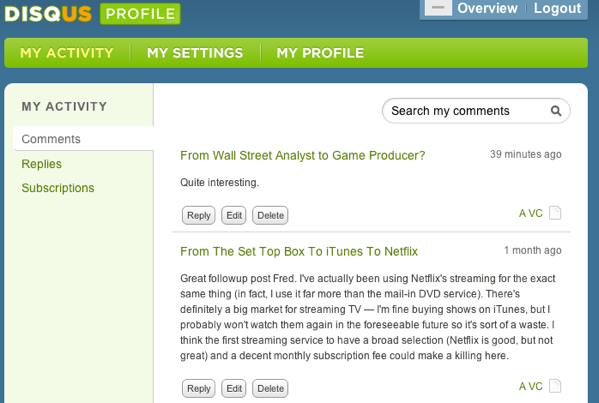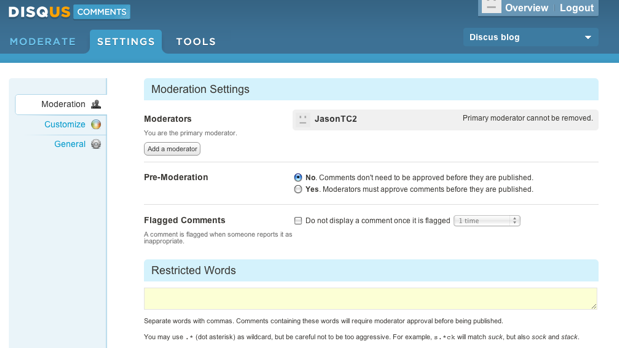 Only a month after rival comment system JS-Kit launched Echo, a real-time comment system, Disqus is striking back with its biggest upgrade since the service launched. Along with a revamped comment system, Disqus 3.0 is also what CEO Daniel Ha calls a “conceptual reconstruction” for the service: Disqus will now be split into two separate but complimentary products, called Comments and Profiles, in recognition of the way two distinct sets of users have been using the commenting engine.
Only a month after rival comment system JS-Kit launched Echo, a real-time comment system, Disqus is striking back with its biggest upgrade since the service launched. Along with a revamped comment system, Disqus 3.0 is also what CEO Daniel Ha calls a “conceptual reconstruction” for the service: Disqus will now be split into two separate but complimentary products, called Comments and Profiles, in recognition of the way two distinct sets of users have been using the commenting engine.
For those who just got worried about losing the Disqus they know and love, fear not: the service isn’t changing all that much. The Comments product has been revamped, but it’s still the commenting engine that bloggers can embed using a few lines of Javascript (we’ve embedded the new comment system below this post if you’d like to try it out for yourself). The new product here is Profiles, which Ha says is designed to cater not to blog administrators, but to empower the people who are actually out there leaving comments.

Profiles isn’t yet another social network you have to maintain. Instead, it’s a central hub for all of the comments you’ve left throughout the web using your Disqus account. From the Profiles panel, you’ll be able to quickly jump to any blog post you’ve ever left a comment on. You’ll also be given control over which comments stay attributed to you — if you find a comment you no longer wish to be associated with, you can delete it from your profile and it will be attributed to an anonymous user on the blog you left it on (I think this could lead to some problems, which I’ll get to below). There’s also an improved account connection system, which allows Disqus to identify comments you’ve left using login systems like Twitter and Facebook Connect and merge them into your profile. The service also features a new emphasis on helping users syndicate their comments out to these social services.

In terms of actually commenting, the new system has a lot in common with Echo. When you leave a comment, it will appear in the comment stream without refreshing. You can also watch other users leave comments in real-time without needing to refresh — you can optionally watch a ‘streaming’ mode, where they appear as they are written, or a ‘queued mode’, which is similar to Twitter Search and the Facebook News Feed in that it shows you a message like “Five new comments.” Busy sites will almost certainly want to enable the latter, as a flowing stream of comments can grow unwieldy quickly (something we saw during our Echo demo).
The service has also increased the speed with which it can suck in comments made about a post elsewhere on the web, like Twitter. Disqus has offered this feature for some time now, but Ha says that the speed has been improved substantially, with around a minute delay to pull in comments that are left offsite. The comment system’s moderation panel has been overhauled as well to accommodate publishers of all sizes, using a Gmail-like label system, along with a number of improvements to its spam tools.

My biggest concern with Disqus 3.0 at this point involves the added control the new Profile feature gives to users. As I mentioned before, you’ll now be able to see a list of every comment you’ve left, and if you find one you no longer wish to have associated with your name, you can simply delete it from your profile. This, in turn, will ‘anonymize’ the comment on the blog it was left on (it will just say ‘Guest’ rather than your name). Blog administrators will always be able to see the name of the person who originally left the comment and can choose to revert back to the user name, but there’s currently no way to disable the feature entirely. This may sound like a minor inconvenience, but it can be problematic for some blogs. For example, sometimes we’ll get comments in our posts that we’ll refer to later on — comments that would lose their value if they no longer reflected who wrote them. Granted, we can always force it back to show the original user name, but this is just one more thing to keep track of. All of that said, I won’t be surprised if Disqus gives blog admins the ability to turn this off in the near future.
Disqus 3.0 looks like a solid upgrade and seems to work quite well. In terms of features, Disqus has a few that Echo lacks (like the ability to pause a stream), while Echo has a few advantages (like the ability to embed video and images, and the option to syndicate to more services including Google and Blogger). But far more important is how the system performs in a real life scenario, under the stresses of day-to-day blog management. Which is why we’ve embedded the revamped comment system below — let’s put this through its paces, but try to keep it sane. We’ll be updating this post later in the day with a few of our observations.